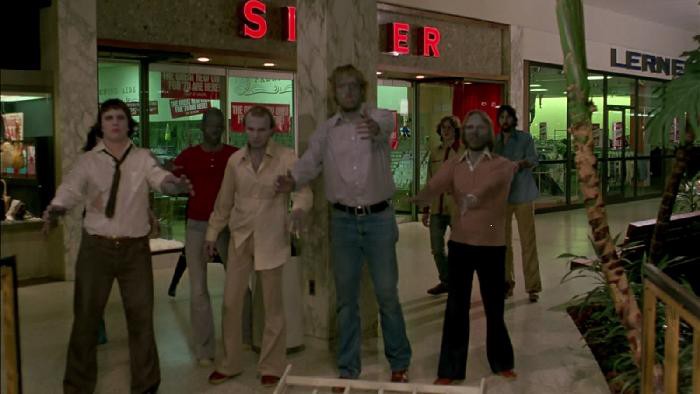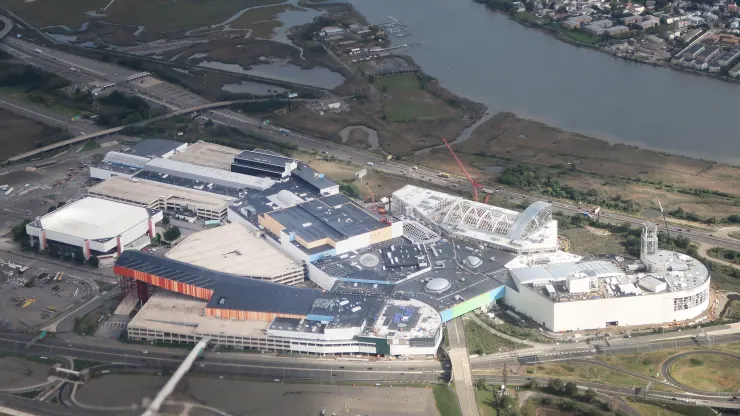In George A. Romero’s 1978 film, Dawn of the Dead, four humans take refuge from a zombie apocalypse in, of all places, a mall. Abandoned, the mall in Dawn of the Dead leaves an eerie impression: this breeding ground for excessive consumerism is haunting when not filled with an excessive number of consumers. But the mall, like the zombies it protects against, is a forceful image in the film, lurching forward and hanging on long past its expiration. More than four decades later, the mall has died and been revived and died again countless times. Like the walking dead, malls are becoming increasingly lifeless, decrepit, and thoughtless, but still continue to push forward. If zombies cannot be killed because they are already dead, malls must not be able to die because they, too, have already concluded their useful life and moved into limbo.

Four decades on from the release of Dawn of the Dead, the film’s images of a lifeless and empty mall found analogs in the opening shots for the American Dream mall in East Rutherford, New Jersey. A three million square foot complex, complete with thirty-three thousand parking spaces to fill up all that floor space up, the American Dream is a mall-that-isn’t-really-a-mall. There is retail, yes, but there is also (perhaps more notably) entertainment galore by way of an ice-skating rink, indoor ski slope, water park, and more, just to name three of the most notable attractions. A consumer does not go to American Dream just to shop, but rather for a day filled with experiences money-can-buy. It is no surprise that malls have been on their way out. 2007 was the first year in more than half a century no new malls were built in the United States. Marking the beginning of the end, malls have since largely become an anachronism in America. The American Dream, then, is a cultural oddity.

The complex, located in the Meadowlands of New Jersey, stands in the shadow of New York City (the culture and consumer capital for the country), Newark Liberty International Airport (one of the nation’s busiest transit hubs), major power generating stations, and MetLife Stadium which hosts cultural events for the metropolitan area. In a very real way, the American Dream mall lies at the crossroads of American consumerism and culture. Its existence is a protest against the mall’s decline, and an active effort to keep in-person consumerism alive. The versatility of the space speaks to the demands of the modern consumer: no longer are material goods enough, experiences are now valued, too. American Dream throws everything at the wall in hopes something will stick. Knowing consumers no longer want just one thing, the challenge has become providing everything. American Dream is just on instance of developers concentrating shopping, experiences, and more into large complexes that leaves everything a consumer could want at their fingertips.
But, as stated above, the mall has outlived its usefulness. Jump the shark attempts to revive the in-person shopping experience, like the construction of American Dream, have been total failures. Through the lens of 2022, malls were just a fad, albeit a long lasting one. The allure of the mall now is not the convenience and ease of shopping (which will never come close to ordering anything at any time to your home from the comfort of your home), but rather the nostalgia they produce. Consumers return to spaces like American Dream to reproduce the heyday of the mall. There are no signs the mall is making a comeback, and so these trips are not genuine emersions, but rather an exercise in history. Visitors to American Dream and its counterparts across the country are performing an old form of consumerism and reliving the way things used to be.
In these ways, the mall will never really die. But they will never really come back to life, either. The mall is stuck, like a zombie, between the states of life and death, its fate always uncertain. In the wake of online ordering, consumers will continue to make trips to malls for the (not so) novel experience of shopping in stores. But these trips will remain the exceptions that prove online shopping’s rule over modern day consumerism.

American Dream itself is an interesting case study in this zombie-like fugue-state of the mall. Conceived in 1996, the idea passed through many hands until ground was finally broken under the name Xanadu in 2004. By 2009, money had gone dry in the wake of the financial crisis, and the complex lay dormant. Successive rounds of construction followed, as tenants began to commit to and then give up a piece of the three million square foot pie. By 2019, plans began to solidify, the exterior got a face lift, and the complex opened with lukewarm occupancy, and even cooler consumer interest. The project has died and come back to life and died again alongside American consumerism, the plan for the mall shifting with prevailing trends in the retail market. When American Dream was first conceived, malls were in their prime, and retailers and financial firms that have since met their end leading up to and in the aftermath of the 2008 financial crisis could never have predicated the end times in 1996.
The name of the complex is an interesting choice. Tagged American Dream, the mall is really an outsized image of the American reality. A confluence of poor planning, poor government regulation, corporate stubbornness, and greed all around, this mall is bloated and out of place. The dream the complex’s title refers to seems to be one of the past: the golden era of the mall and in-person consumerism. With the mall on decline, these spaces increasingly exist in the cultural imagination, with sites like these as the locations to play out these historical fantasies. Much like a dream, then, American Dream is real in theory, but not in practice. The structure’s struggle to live and die and live again makes this three million square foot monstrosity a recapitulation of prevailing cultural trends. It is a site on which we can project anxieties for the future, replay nostalgia of the past, and everything in between. Then, American Dream is like the zombie’s depicted in Dawn of the Dead, neither living, nor dead, constantly stuck in tension, its fate forever unknown.
Bibliography:
In addition to personal experience growing up near American Dream and hearing about its progress, I drew from the following sources:
www.nytimes.com/2019/12/27/arts/american-dream-mall-opening.html
www.smithsonianmag.com/arts-culture/death-and-rebirth-american-mall-180953444/
www.cnbc.com/2019/10/22/timeline-of-new-jerseys-american-dream-megamall-and-how-it-got-built.html
www.nytimes.com/2015/01/04/business/the-economics-and-nostalgia-of-dead-malls.html
www.wsj.com/articles/american-dream-a-giant-mall-outside-manhattan-aims-to-ride-luxury-wave-11627992000
www.americandream.com
George A. Romero’s Dawn of the Dead (1978)
